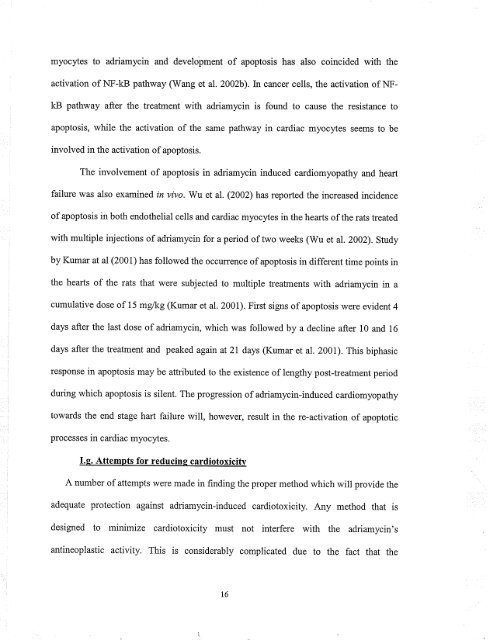il\VOLVEMENT OF RETII\OIC ACID II{ - MSpace at the University of ...
il\VOLVEMENT OF RETII\OIC ACID II{ - MSpace at the University of ...
il\VOLVEMENT OF RETII\OIC ACID II{ - MSpace at the University of ...
Create successful ePaper yourself
Turn your PDF publications into a flip-book with our unique Google optimized e-Paper software.
myocytes to adriamycin and development <strong>of</strong> apoptosis has also coincided with <strong>the</strong><br />
activ<strong>at</strong>ion <strong>of</strong> NF-kB p<strong>at</strong>hway (Wang et a1.2002b). In cancer cells, <strong>the</strong> activ<strong>at</strong>ion <strong>of</strong> NFkB<br />
p<strong>at</strong>hway after <strong>the</strong> tre<strong>at</strong>ment with adriamycin is found to cause <strong>the</strong> resistance to<br />
apoptosis, while <strong>the</strong> activ<strong>at</strong>ion <strong>of</strong> <strong>the</strong> same p<strong>at</strong>hway in cardiac myocytes seems to be<br />
involved in <strong>the</strong> activ<strong>at</strong>ion <strong>of</strong> apoptosis.<br />
The involvement <strong>of</strong> apoptosis in adriamycin induced cardiomyop<strong>at</strong>hy and heart<br />
failure was also examined in vivo. 'Wu et al. (2002) has reported <strong>the</strong> increased incidence<br />
<strong>of</strong> apoptosis in both endo<strong>the</strong>lial cells and cardiac myocytes in <strong>the</strong> hearts <strong>of</strong> <strong>the</strong> r<strong>at</strong>s tre<strong>at</strong>ed<br />
with multiple injections <strong>of</strong> adriamycin for a period <strong>of</strong> two weeks (Wu et al. 2002). Study<br />
by Kumar <strong>at</strong> al (2001) has followed <strong>the</strong> occurrence <strong>of</strong> apoptosis in different time points in<br />
<strong>the</strong> hearts <strong>of</strong> <strong>the</strong> r<strong>at</strong>s th<strong>at</strong> were subjected to multiple tre<strong>at</strong>ments with adriamycin in a<br />
cumul<strong>at</strong>ive dose <strong>of</strong> 15 mg/kg (Kumar et al. 2001). First signs <strong>of</strong> apoptosis were evident 4<br />
days after <strong>the</strong> last dose <strong>of</strong> adriamycin, which was followed by a decline after 10 and 16<br />
days after <strong>the</strong> tre<strong>at</strong>ment and peaked again <strong>at</strong> 2I days (Kumar et al. 2001). This biphasic<br />
response in apoptosis may be <strong>at</strong>tributed to <strong>the</strong> existence <strong>of</strong> lengthy post-tre<strong>at</strong>ment period<br />
during which apoptosis is silent. The progression <strong>of</strong> adriamycin-induced cardiomyop<strong>at</strong>hy<br />
towards <strong>the</strong> end stage hart failure will, however, result in <strong>the</strong> re-activ<strong>at</strong>ion <strong>of</strong> apoptotic<br />
processes in cardiac myocytes.<br />
I.g. Attempts for reducine cardiotoxicÍty<br />
A number <strong>of</strong> <strong>at</strong>tempts were made in finding <strong>the</strong> proper method which will provide <strong>the</strong><br />
adequ<strong>at</strong>e protection against adriamycin-induced cardiotoxicity. Any method th<strong>at</strong> is<br />
designed to minimize cardiotoxicity must not interfere with <strong>the</strong> adriamycin's<br />
antineoplastic activity. This is considerably complic<strong>at</strong>ed due to <strong>the</strong> fact th<strong>at</strong> <strong>the</strong><br />
t6







![an unusual bacterial isolate from in partial fulf]lment for the ... - MSpace](https://img.yumpu.com/21942008/1/190x245/an-unusual-bacterial-isolate-from-in-partial-fulflment-for-the-mspace.jpg?quality=85)





![in partial fulfil]ment of the - MSpace - University of Manitoba](https://img.yumpu.com/21941988/1/190x245/in-partial-fulfilment-of-the-mspace-university-of-manitoba.jpg?quality=85)


